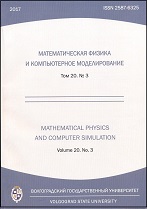|
Physics
Estimation of potential noise resistance of the algorithm for detecting modulation type of narrowband signals using numeric modeling
V. D. Zakharchenko
Volgograd State University
Abstract:
Transmission of information through space in radiotechnics is achieved using signals modeled by finite functions of the form $x(t)=A(t)\cos[\omega_0t+\Theta(t)]$ , where $A(t)$ and $\Theta(t)$ (amplitude and phase) are time functions slow comparatively to $\omega_0t$. Preliminary estimate of modulation type of such signals can be performed in time domain based on an integral narrowbandness criterion, according to which the radiosignal modulation type (amplitude (AM) or angular (PM, FM)) is estimated by their input in the left-hand side of the inequality:
$$
\left\|\frac{dA}{dt}\right\|+\left\|A\frac{d\Theta}{dt}\right\|\ll\omega_0\|A\|
$$
The norms corresponding to modulation types included in the inequality are computed in time domain
from the signal model $x(t)$ based on evaluations of the envelope $A(t)$ phase $\Theta(t)$ using hilbert transform. The article presents the structure of an algorithm implementing computation and comparison of the norms $\|dA/dt\|$ and $\|Ad\Theta/dt\|$.
Statistical modelling is used to estimate the potential noise resistance of the modulation type detection algorithm through calculation of its accuracy in presence of additive noise. Test samples included AM and FM radiosignals with low modulation index $(m = 0.5)$ with nearly identical energetic spectra. Noise resistance estimation was performed by calculating the correct decision rate.
It is shown that noise resistance of the proposed algorithm enables definite discrimination of amplitude and phase modulation for noise levels up to 10 dB above the signal; phase-modulated signals are detected with greater accuracy.
Keywords:
narrowband signal, numeric modelling, potential noise resistance, integral criterion, detection algorithm.
Citation:
V. D. Zakharchenko, “Estimation of potential noise resistance of the algorithm for detecting modulation type of narrowband signals using numeric modeling”, Vestnik Volgogradskogo gosudarstvennogo universiteta. Seriya 1. Mathematica. Physica, 2017, no. 2(39), 94–97
Linking options:
https://www.mathnet.ru/eng/vvgum176 https://www.mathnet.ru/eng/vvgum/y2017/i2/p94
|

| Statistics & downloads: |
| Abstract page: | 123 | | Full-text PDF : | 45 | | References: | 34 |
|




 Contact us:
Contact us: Terms of Use
Terms of Use
 Registration to the website
Registration to the website Logotypes
Logotypes







 Citation in format
Citation in format 